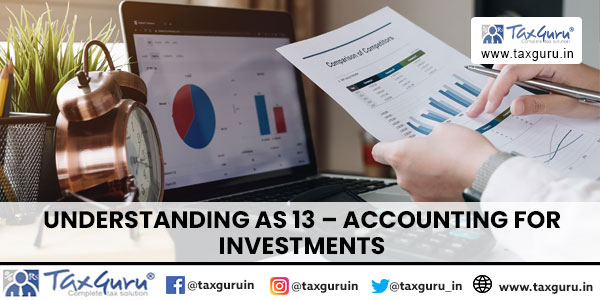Accounting Standard (AS) 13 outlines the principles and procedures for accounting for investments in the financial statements of an enterprise. This standard addresses the classification, measurement, and disclosure of investments, excluding interest, dividends, and rentals recognized under other standards. AS 13 provides clarity on the handling of current and long-term investments, investment properties, and the requirements for reclassification and disclosure in financial statements. Understanding AS 13 is crucial for accurate financial reporting and compliance with accounting regulations.
OBJECTIVE AND SCOPE :
This standard deals with accounting of investments in financial statements of enterprise and related disclosure matters.
This standard does not deal with –
1. the basis of recognition of interest, dividends and rentals earned on investment which are covered by AS 19
2. operating or finance lease
3. mutual funds and venture capitals funds or assets related to management of the companies, banks, and public financial institutions under state or central government act or so declared under companies act.

MEANING OF INVESTMENT :
- Investment are held by the enterprise
- earning income by way of dividends, interest, and rentals for capital appreciations or for other benefits to the investing enterprise
- assets held as stock in trade(inventories) are not investments.
FORMS OF INVESTMENTS :
- Current investments is as investment that is by its nature readily realisable and is intended to be held for not more than one year from the date on which such investment is made.
- the intention to hold not more than one year is made at the time of purchase of the investment.
- A long term investment is an investment other than a current investment.
INVESTMENT PROPERTIES :
- An investment property is an investment in land or building that are not intended to be occupied substantially for the use by or in the operation of the investing enterprise.
- an investment property is accounted for in the accordance with cost model as prescribed in AS 10 (revised), ‘property plant and equipment’. the cost of any shares in the corperative society or a company, the holding of which is directly related to the right to hold the investment property, is added to the carrying amount of the investment property.
CARRYING AMOUNT OF INVESTMENTS :
- the carrying amount of current investment is lower of cost and fair value.
- Long term investment are usually carried at cost. the carrying amount of long term valued investments is therefore determined on an investment basis.
- where there is a decline, other than the temporary, in the carrying amounts of the long term valued investments, the resultant reduction in the carrying amount is charged to the profit and loss statement. the reduction in carrying amount is reversed when there is a rise in the value of the investment, or if the reasons for the reduction no longer exists.
RECLASSIFICATION OF INVESTMENTS :
- where long term investment are reclassified as current investments, transfers are made at the lower of cost and carrying amount at the date of transfer.
- where investments are classified from current to long term, transfer are made at the lower of cost and fair value at the date of transfer.
DISCLOSURE :
The following disclosures in financial statements in relation to investments are appropriate: –
a. The accounting policies followed for the determination of carrying amount of investments.
b. The amounts included in profit and loss statement for:
i. Interest, dividends (showing separately dividends from subsidiary companies), and rentals on investments showing separately such income from long term and current investments. Gross income should be stated, the amount of income tax deducted at source being
included under Advance Taxes Paid.
ii. Profits and losses on disposal of current investments and changes in carrying amount of such investments.
iii. Profits and losses on disposal of long term investments and changes in the carrying amount of such investments.
c. Significant restrictions on the right of ownership, realisability of investments or the remittance of income and proceeds of disposal.
d. The aggregate amount of quoted and unquoted investments, giving the aggregate market value of quoted investments.
e. Other disclosures as specifically required by the relevant statute governing the enterprise.
f. Classification of investments.
Conclusion: AS 13 plays a vital role in ensuring transparency and accuracy in the accounting of investments. By clearly defining the treatment of various types of investments and the necessary disclosures, this standard helps enterprises maintain consistency and reliability in their financial statements. Adhering to AS 13 enables better decision-making and enhances stakeholder confidence in the financial health of the enterprise. Proper implementation of this standard is essential for achieving sound financial management and regulatory compliance.




